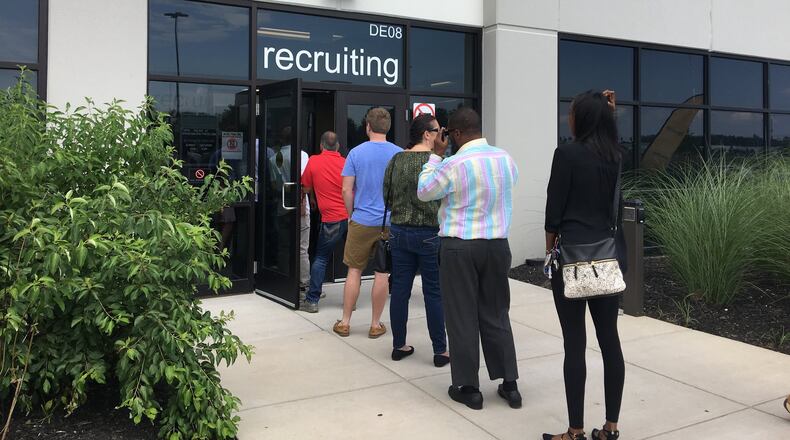The survey also shows 80% of those who are planning to leave their job are concerned about career growth and 75% who say the pandemic made them rethink their skill sets.
The nation’s workforce is right at the beginning of a “tsunami” of people changing jobs, according to David Cathey, a partner with recruiting company Unity Search Group.
“At my firm, since September, we have had consecutive job order growth month over month and it’s only increasing,” Cathey said. “We’re not seeing that slow down.”
A year into the pandemic, 68% of American workers say that having the ability to work both remotely and at the work site is the ideal workplace model, according to the survey. Of workers who have been working remotely during the pandemic, 87% want to continue working remotely at least one day a week once the pandemic subsides.
Cathey said the job hopping trend can be categorized by three distinct areas. The first is those who had every intention of changing jobs last year but did not do so because they were worried about the last person hired at a new company and feared getting let go due to the coronavirus pandemic.
The second one is natural attrition, meaning “people who were going to leave this year anyways,“ he said.
“The third one is what the industry has been calling a corporate coronavirus response, and it’s how companies have been responding to the coronavirus and how that’s impacted employees, whether that’s they responded appropriately (or) they’ve been trying to force people back into the office too early,” Cathey said. “There has been a significant culture decay across many organizations because we’re just not connected as we were before the pandemic.”
Although some employees may chafe at being brought back into the office too early, there are also others who actually yearn to get back there.
Unity Search Group’s recent survey about what people want to see moving forward showed the overwhelming majority wanted to see some type of hybrid of being in the office some days and at home on others, Cathey said.
“I think what workers have found out is that life is short and they really want to be satisfied with the work that they’re doing and the company that they are working for,” he said. “A lot of people have realized they have a particular unique skill-set that doesn’t necessarily align with what their education or their career path is leading to at this point in time, and so they’re more willing to take the risk and move on and do something else.”
Rather than watch employees, especially hard-to-replace high-skilled workers move on and create massive headaches for companies, employers should open the lines of communication to employees and show them a career path and succession plan and then help them get there, Cathey said.
“The corporate response is just going to be absolutely critical to retain your top level employees and that starts with listening,” he said.
Seventy-three percent of all workers say employers should continue to offer and expand remote-work options even after the pandemic is over, according to Prudential’s survey. Among current remote workers that percentage is even higher: 83%.
“Human being are social beings,” Cathey said. “By and large, we need community and by being forced to be at home, they feel disconnected from their work. On one hand they’re looking for remote work, but on the other hand, it’s causing them, this trial that we were forced to go through last year, caused them to realize that they need community.”
Millennials are the largest generation in the workforce and 1 in 3 say they are planning to look for a new job with a different employer once the pandemic is no longer an issue, according to Prudential’s survey, compared to 25% of Generation X-ers and just 10% of Baby Boomers.
“It’s just a generational difference,” said Michael Zimmerman, public information officer, for Montgomery County Business Services. “You look at the difference at someone who was working in the middle of their career, say, 30 years ago, the tradition was that you worked at the same company for the lifetime of your career. Whereas now, the workplace is a market-driven industry just almost by itself. It’s more readily available what certain skills are worth and … when you get some sort of new certification or new skill, the tendency is to shop that around, right?”
With that comes less of a tendency by companies to be turned off by a potential candidate whose resume is littered with job changes over a certain time period, Zimmerman said.
“If you look at the resume … that’s basically how they’ve gotten promotions is to go from one position where there might not have been openings for improvement there (and) move onto another place where it’s a step up,” he said.
BY THE NUMBERS
26%: amount of workers who plan to look for a job at a different company once the pandemic has subsided
80%: amount of those who are planning to leave their job and who are concerned about career growth
75%: amount of those who are planning to leave their jobs who say the pandemic made them rethink their skill sets.
68%: amount of of American workers who say that having the ability to work both remotely and at the work site is the ideal workplace model
87%: amount of workers among those who have been working remotely during the pandemic that want to continue working remotely at least one day a week once the pandemic subsides.
34%: number of workers planning to bolt their jobs among Millennials
25%: number of workers planning to bolt their jobs among Generation X
10%: number of workers planning to bolt their jobs among Baby Boomers
Source: Prudential Financial’s Pulse of the American Worker Survey
About the Author

